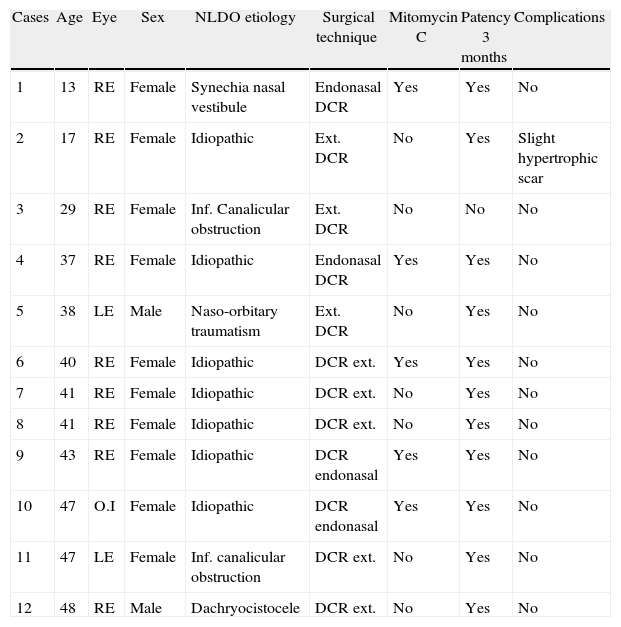To study the relative frequency, causes, anatomical and functional outcomes and complications of dacryocystorhinostomy (DCR) in patients between the second and fifth decade of life.
MethodA retrospective, nonrandomized, interventional study of a clinical series of 12 patients who underwent DCR from March 2007 to March 2009, performed by a single surgeon, with an age range between 10 and 48 years. Recorded data included age at surgery, date of surgery, gender, affected side, cause of obstruction, surgical technique, outcome, and complications. The relative frequency of such cases over the total was calculated.
ResultsDCR in patients between 13 and 48 years old represented 14.11% of the total (12:85). In this group 88.8% were females and in 75% surgery was on the right side. The most frequent cause of obstruction was low idiopathic obstruction (58.33%) whereas 41.66% were secondary. An external DCR was performed on 66.67% of patients and the rest were endonasal DCR. Anatomical success was achieved with resolution of symptoms in 91.6% of patients. One case had a hypertrophic scar.
ConclusionAdolescents and young adults represent a significant percentage of cases undergoing DCR surgery. Both the external and endoscopic approaches are shown to be valid alternatives for treating these patients, with good results and low incidence of complications.
Estudiar la frecuencia relativa, causas, resultados anatómicos, funcionales y complicaciones de la dacriocistorrinostomía (DCR) en pacientes entre la segunda y quinta décadas de la vida.
MétodoEstudio retrospectivo, no aleatorizado, intervencional de una serie de casos clínicos, de 12 pacientes intervenidos de DCR desde marzo de 2007 hasta marzo de 2009, realizadas por un cirujano único, con un rango de edad comprendido entre los 10 y los 48 años. Registrándose edad, día de cirugía, género lateralidad, causa de la obstrucción de conducto nasolagrimal (OCNLG), técnica quirúrgica, resultado de la intervención y complicaciones. Se calculó la frecuencia relativa de estos casos respecto del total.
ResultadosLa DCR en pacientes entre 13 y 48 años representaba el 14,11% del total (12:85). En este grupo el 88,8% eran mujeres y en la cirugía el 75% estaba en el lado derecho. La causa más frecuente de obstrucción fue la obstrucción baja idiopática (58,33%), mientras que 41,66% eran secundarias. En el 66,67% de los pacientes una DCR externa se llevó a cabo y el resto fue DCR endonasal. En el 91,6% de los pacientes se logró éxito anatómico con la resolución de los síntomas. Un caso presentó cicatriz hipertrófica.
ConclusiónLos adolescentes y adultos jóvenes representan un porcentaje significativo de casos que reciben cirugía DCR. Tanto el abordaje externo como el endoscópico representan una alternativa válida para el tratamiento de estos pacientes con buenos resultados y baja incidencia de complicaciones.










